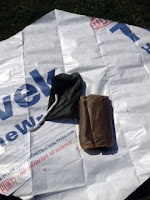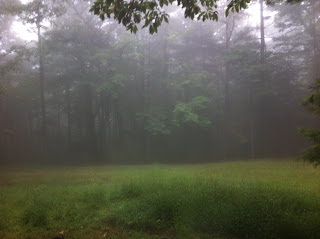The New Tent: The LightHeart Gear Solo Standard.
 |
| LighHeart Gear Solo |
If you have been following the blog, you have been exposed to some of my discussion of tents, tarps and hammocks and now have an idea of the different though processes people have for purchasing each type of shelter. I have been going through a very similar thought process recently regarding the purchase of a new shelter for the late winter/early spring portion of my hike.
I have multiple shelters to choose from for the hike. For the majority of the hike, I am planning on using either a hammock or more likely my tarp. The tarp is the obvious choice for light weight, and the hammock, although heavier will sleep more comfortably and may be the choice for most of the hike if I decide to try to stay away from the shelters with the problems of overcrowding, snoring, and mice. However, I have been thinking about the beginning of the hike, especially if the weather is mild and I start hiking early in the season. By starting in mid February I can beat the crowds that are associated with a late March or early April start. The danger of such an early start is of course the weather. The mountains of Georgia, North Carolina and the Smokey Mountains are guaranteed to be cold, the gamble is how much ice and snow I could encounter. I am trying to minimize the risk of snow and ice by only starting such an early hike only if the winter has been mild. However, I do realize that even with a mild winter I must be prepared for severe weather and this has help make my decision to purchase a tent.
If in the case of snow and ice, the obvious choice of shelter if I am not able to get into a close town is to wait out the weather in a shelter. However, depending on how severe the weather becomes, my location on the trail, how I am fairing physically, the shelter may not be close enough to travel to. In that case I have to have a back up plan and other shelter available.
My tarp could be a viable shelter. It is my go to shelter for the summer portion of my hike. It will work but has some possible drawbacks. First, even in a storm pitch, there is one side that remains open, if the wind shifts it can expose the occupant to the weather requiring repitching the tarp in a different direction. Secondly, if I have to pitch the tarp over snowy, icy or muddy ground, there is the problem of moisture and the chance of wet sleeping bags and clothes. This is not something that I would want to deal with extreme weather.
My hammock would be an excellent shelter as it is pitched above ground and as such there is no issues of having to deal with snow, ice and mud on the ground. You will hang over the mess. With a tight pitch of the hammock tarp, the tarp should shed any snow buildup easily. There are two drawbacks of the hammock. First, is that if I have to shelter over for several days, the hammock would be tight and cramped if I had to basically lay in it for a day or two, Secondly, in order to be warm in the hammock, I am going to have to carry several pounds of additional insulation (called underquilts and overquilts) to keep warm. The hammock is a usable shelter, but with additional weight and space requirements of additional insulation as well as being confining if I had to shelter in it for several days, I do not look forward to using a hammock for this portion of my hike.
So the other choice is carrying a tent. The tent allows me to clear away snow on the ground, lay a ground cloth down to protect the floor of the tent from moisture, The tent obviously has an enclosed entryway and as it is enclosed, may potentially be warmer than the outside air temperature due to helping to keep body heat in the enclosed space. Shedding of snowfall on the outside of the tent, with the right design should be workable as well. After reviewing all the options, I elected to go with a tent. Now the fun began, what tent to buy.
 |
No tent poles with this tent! It uses your
trekking poles to drop weight. |
Well, without rehashing cuben fiber vs Sil-nylon, i opted to carry a few more ounces and go with a hybrid sil-nylon tent by Lightheart Designs. A hybrid designed tent is a tent that is partially a single wall tent as well as areas that have a double wall design. (typically similar to a rain fly.) This tent is large enough for a person and their gear, and the design should hopefully allieve some of the issues of condensation that are extremely common with single walled tents, keeping me drier if I have to hole up in the tent for several days. The generous space of this tent should allow me to move around a bit, dress, or read and play cards to cut the boredom while couped up.
 |
| LightHeart Solo. Fly folded up |
The LightHeart Solo may find it stays in the pack well past Damascus VA if the spring is wetter than usual. As it is a fairly light tent and is enclosed with bug netting it may be an option instead switching out early to the tarp. The tarp and a bug shelter will weigh about 24 ounces and the tent only weighs 27 ounces so it could definitely stay in the pack longer till we get past the worst of the mosquito season.
So, the tent has been ordered and should be here in the next day or two. Seam sealing will be done this weekend and I will be taking this tent on the trails over the next couple of weeks during my shakedown hikes. So be looking for a review of the tent shortly. Until then, check out these unique tents at www.lightheartgear.com for further specs and information.
Following the Compass Rose North.
AT Hiker......










